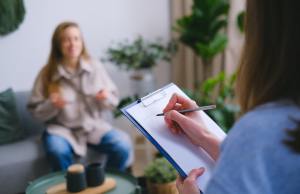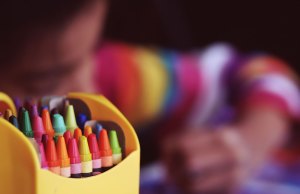ADHD is something that many people around the world have to deal with every day, but it can be especially difficult for kids. Children with ADHD often struggle with their neurodivergent characteristics, making things like focusing at school and sitting quietly and respectfully for long periods of time much more difficult.
Having ADHD as a child can certainly feel like a hurdle, but with the right treatment and attention from parents and teachers, kids with ADHD can thrive in any setting.

What Is the Difference Between ADHD in Kids and ADHD in Adults?
The main difference between ADHD in children and adults is that hyperactivity is less obvious in adults. This can mean that either an adult with ADHD has learned coping skills to mask their symptoms more effectively, or their symptoms have evolved into something less noticeable. For example, adults with ADHD experience hyperactivity more like restlessness, sometimes finding it difficult to sit through meetings or meals.
However, ADHD adults will often continue to portray symptoms of inattentiveness and impulsivity depending on their personal set of symptoms.
In fact, most adults with ADHD, specifically those that were diagnosed later in life or were never diagnosed, are better at masking their symptoms than children. Over the course of their lives, they had to find ways to cope with their symptoms on their own, since they had no help from medication or therapy. Some of these coping skills can be healthy and beneficial, but often some of them can prove to be helpful in the short-term, not the long-term.
What Are the Signs for ADHD in a Child? What Are the 4 Symptoms of ADHD in Children?
Though there are many small patterns that can point to ADHD in children, there are four main symptoms or signs of ADHD in kids: hyperactivity, impulsivity, disorganization, and inattentiveness.
Kids with ADHD can display elements of each symptom type, but they can usually be placed under one of three ADHD subtypes based on what their symptoms are: predominantly hyperactive-impulsive, predominantly inattentive, and combined inattentive and hyperactive or impulsive.
Examples of inattentive ADHD symptoms in children include:
- Trouble focusing, easily distracted
- Difficulty staying on task
- Issues with organization
- Forgetfulness, frequently loses belongings
- Difficulty approaching tasks that require more mental energy or prolonged focus
- Not very attentive to detail, makes careless mistakes
- Trouble following instructions or completing tasks
Hyperactive-impulsive ADHD will look somewhat different, with symptoms like:
- Constant fidgeting, difficulty sitting still
- Causing disruptions
- Excessive movement like climbing and jumping
- Impulsivity, like Interrupting others and not asking for permission
- Talkativeness
- Difficulty working quietly
- Gets up often during class
Children with a combined type presentation will have both inattentive and hyperactive-impulsive behaviors, like:
- Disorganization
- Issues with time management
- Feeling very overwhelmed
- Poor performance in school
- A history of anxiety and depression
Other ADHD signs that pertain to each of the subtypes include poor academic performance, difficulties with friendships, frequent irritability, feelings of low self-esteem, and displaying unmanageable behaviors.
What Causes ADHD in Children?
Some research points to ADHD being genetically inherited, with children typically having a parent with ADHD.
However, ADHD can also sometimes be attributed to a person’s brain function and structure. Kids can also be at risk of developing ADHD if they’re born premature, exposed to environmental toxins such as lead, exposed to drugs during pregnancy, or have epilepsy or a brain injury.
Hello, we're here to help you
We provide award-winning mental health services nationwide, with flexible scheduling & insurance coverage. Start your journey this week.
What Triggers ADHD in Children?
In terms of environmental factors that set off a child’s ADHD, there are multiple stressors that can make a child’s ADHD temporarily worse. One of the biggest factors is stress itself. ADHD already makes someone vulnerable to feeling overwhelmed easily, so when extra stress is added to the mix, simple tasks can feel impossible to do.
Poor sleep, overstimulation, and too much technology can also be detrimental for a child with ADHD. Not getting enough sleep and feeling overstimulated, like stress, can make a kid with ADHD feel easily overwhelmed, often causing ADHD paralysis and making it extremely hard for them to pay attention.
Technology can be helpful in certain doses for kids with ADHD, but if it’s too heavily involved in their day, little notifications and the multitude of distractions it can offer can cause them to get sidetracked as well as feel overstimulated.
At What Age or Stage of Child Development Can You Begin Diagnosing ADHD?
Typically, children are diagnosed with ADHD during the school age years, starting at around age six. It’s too difficult to diagnose in children younger than school age due to their naturally short attention span and ease of being distracted. One criteria of an ADHD diagnosis is that one must have exhibited ADHD symptoms before the age of 12.
However, many people with ADHD, especially girls and women, don’t get diagnosed until adulthood, if ever. This can often be the case for children and adults with inattentive ADHD, since the symptoms of hyperactive-impulsive ADHD are much easier to spot and more commonly associated with ADHD.
How Can a Teacher Help a Child With ADHD?
Kids with ADHD are no less capable than neurotypical children, but catering to ADHD kids’ learning needs will help them thrive in a space that isn’t necessarily made for them. The stillness, quietness, and long, timed periods in which students are expected to work are things that ADHDers struggle with.
By listening to their needs and restructuring an ADHD kid’s school day, teachers can give them the tools they need to succeed. There are many tactics that teachers learn about and implement in their classrooms to help ADHD students. Some of these include:
- Instituting a behavioral plan with positive reinforcement and feedback
- Providing assistance with studying and organizational skills
- Giving them extra time for tests and assignments
- Providing them with clear and direct instructions for tasks, repeating them as needed
- Allowing them breaks to get up and move around
- Giving them preferential seating in the classroom
- Assisting with a 504 plan or obtaining an Individualized Education Plan (IEP)
Each of these approaches can be used to effectively help adapt a learning environment to the needs of ADHD students.
How to Treat ADHD in Kids
While there is no “cure” for ADHD, treatment for ADHD children can include medication, education, therapy, and/or a combination of them all, depending on the needs of the child and the effectiveness of the treatments.
Medication is usually the first route for treatment suggested by mental health professionals, and can be prescribed in stimulant or non-stimulant varieties. Some of the most common non-stimulant medication options for kids with ADHD include Strattera, Guanfacine, and Clonidine.
Common stimulant ADHD medication, also called psychostimulants, are Amphetamines (such as Adderall and Vyvanse) and Methylphenidate (such as Concerta and Focalin). However, many psychotherapists don’t prescribe stimulant medications due to the high risk of abuse and various side effects.
Therapy approaches typically include one or more of the following: behavioral therapy, cognitive behavioral therapy (CBT), or family therapy, each of which involves a version of talk therapy. The main objective is to learn good coping strategies and life-management skills, which would help regulate one’s symptoms and perhaps increase self-esteem.
Talk therapy is a common treatment technique, but other ADHD-focused coaching is helpful depending on your personal circumstances and symptoms.
Outside of therapy and medication, it’s also important to educate children and their families on ways to cope, develop new skills, and be supportive. Staying informed and understanding what an ADHD child is dealing with will help those around them better support and advocate for them.













